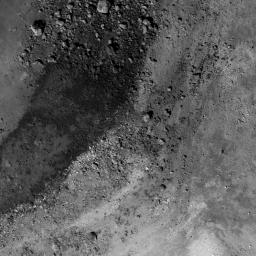
|
Up from the Depths
- Click the image above for a larger view
- Full-Res JPEG (1400 x 1400) (417.0 kB)
- Full-Res TIFF (1400 x 1400) (2.0 MB)
Caption:
Close up view of the central peak of Aristarchus crater, 700 meters, or 2296 feet, wide, NAC M122523410.
Crater central peaks are formed as the Moon's crust rebounds after the tremendous stress of an impact is released. The energies of impacts are so high that rocks no longer behave as brittle solids, but rather as deformable plastic. It's more accurate to think of the crust behaving like a fluid -- as the crater forms, the bottom of the crater is first pressed down, then it rebounds. For craters above 20 km in diameter, the rebound is so strong that material from depth is actually brought up and forms a central peak. In the case of Aristarchus crater, the central peak contains rocks with three very different albedos. As these materials erode out of the central peak they slide downslope, creating contrasting stripes. The highest albedo material reflects about four times as much light as the lowest albedo rocks.
Background Info:
NASA's Goddard Space Flight Center built and manages the mission for the Exploration Systems Mission Directorate at NASA Headquarters in Washington. The Lunar Reconnaissance Orbiter Camera was designed to acquire data for landing site certification and to conduct polar illumination studies and global mapping. Operated by Arizona State University, LROC consists of a pair of narrow-angle cameras (NAC) and a single wide-angle camera (WAC). The mission is expected to return over 70 terabytes of image data.
Cataloging Keywords:
| Name | Value | Additional Values |
|---|---|---|
| Target | Moon | |
| System | Earth | |
| Target Type | Satellite | |
| Mission | Lunar Reconnaissance Orbiter (LRO) | |
| Instrument Host | Lunar Reconnaissance Orbiter | |
| Host Type | Orbiter | |
| Instrument | Lunar Reconnaissance Orbiter Camera (NAC) | |
| Detector | Narrow Angle Camera (NAC), Wide Angle Camera (WAC) | |
| Extra Keywords | Crater, Grayscale, Impact | |
| Acquisition Date | ||
| Release Date | 2010-07-20 | |
| Date in Caption | ||
| Image Credit | NASA/GSFC/Arizona State University | |
| Source | photojournal.jpl.nasa.gov/catalog/PIA13498 | |
| Identifier | PIA13498 | |
